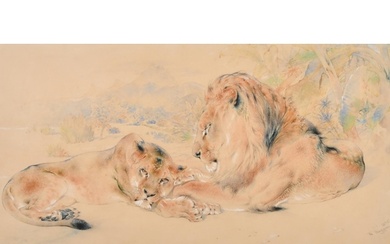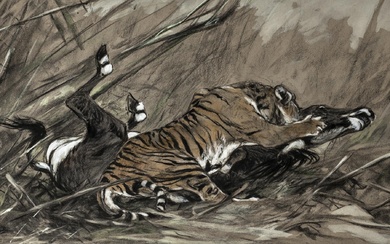William Huggins (1820 - 1884) Two pumas in a landscape Oil o...
Estimate
£15,000 - £20,000
William Huggins (1820 - 1884)
Two pumas in a landscape
Oil on panel
Signed and dated, 'W. Huggins 1840'
Exhibition and gallery labels, verso
Provenance:
Ex-Collection, the Master of Kinnarid;
with Ackerman & Johnson, 1966, from whom purchased by;
Mary Lou Cashman, Illinois.
Exhibited:
Oscar and Peter Johnson Ltd., The Lowndes Lodge Gallery, November 1966, no. 39.
Lot Essay:
William Huggins was born in Liverpool in 1820. Huggins shared many characteristics with George Stubbs, revealing a precocious talent for drawing and painting. Aged only 15, he won a prize at the Liverpool Mechanics Institute, where he studied before entering the Liverpool Academies School, with Richard Ansdell, in 1835. Huggins spent much time at the zoological Gardens in Liverpool, studying the animals, as well as following Wombwell's Menagerie from place to place. It wasn't until 1850, however, the he was to become a full member of the Liverpool Academy.
Like Stubbs, who, much to his own annoyance, was never able to rid himself of the label 'horse painter', Huggins was unable to escape from the description of 'animal painter', despite his evident dislike of the term. In the first half of the 19th century, as in the 18th century, the hierarchy of painting was comparatively rigid, and being an animal painter did not carry as much weight as being either a portrait or a landscape painter. However, in Liverpool, there was only a limited market for history painting during that period, and, as elsewhere in the provinces, portraits, landscapes, and animal paintings were popular instead.
Ben Marshall (1768 - 1835), a Leicestershire painter, once said, "I discover many a man who would pay me 50 guineas for painting his horse, who thinks 10 guineas is too much for painting his wife."
Huggins' technique is very particular to him, as he employed a very distinctive glazing of colours on his prepared boards and canvases. Typically, he used a white millboard as the ground for his transparent glazes. His knowledge of animal anatomy was profound. E. Rimbault Dibdin, in his article on Liverpool-born animal painters (Art Journal, 1904), praised Huggins as a master; "Both as an executant in paint, and as a consummate expert in knowledge of animal form and character, Huggins was qualified to out-distance both Landseer and Ansdell." It was only his shy and slightly eccentric character that stopped Huggins from doing so.
Dimensions:
(Panel) 20 in. (H) x 26 in. (W)
(Frame) 25 in. (H) x 31.25 in. (W)
Estimate
Time, Location
Auction House
Estimate
£15,000 - £20,000
William Huggins (1820 - 1884)
Two pumas in a landscape
Oil on panel
Signed and dated, 'W. Huggins 1840'
Exhibition and gallery labels, verso
Provenance:
Ex-Collection, the Master of Kinnarid;
with Ackerman & Johnson, 1966, from whom purchased by;
Mary Lou Cashman, Illinois.
Exhibited:
Oscar and Peter Johnson Ltd., The Lowndes Lodge Gallery, November 1966, no. 39.
Lot Essay:
William Huggins was born in Liverpool in 1820. Huggins shared many characteristics with George Stubbs, revealing a precocious talent for drawing and painting. Aged only 15, he won a prize at the Liverpool Mechanics Institute, where he studied before entering the Liverpool Academies School, with Richard Ansdell, in 1835. Huggins spent much time at the zoological Gardens in Liverpool, studying the animals, as well as following Wombwell's Menagerie from place to place. It wasn't until 1850, however, the he was to become a full member of the Liverpool Academy.
Like Stubbs, who, much to his own annoyance, was never able to rid himself of the label 'horse painter', Huggins was unable to escape from the description of 'animal painter', despite his evident dislike of the term. In the first half of the 19th century, as in the 18th century, the hierarchy of painting was comparatively rigid, and being an animal painter did not carry as much weight as being either a portrait or a landscape painter. However, in Liverpool, there was only a limited market for history painting during that period, and, as elsewhere in the provinces, portraits, landscapes, and animal paintings were popular instead.
Ben Marshall (1768 - 1835), a Leicestershire painter, once said, "I discover many a man who would pay me 50 guineas for painting his horse, who thinks 10 guineas is too much for painting his wife."
Huggins' technique is very particular to him, as he employed a very distinctive glazing of colours on his prepared boards and canvases. Typically, he used a white millboard as the ground for his transparent glazes. His knowledge of animal anatomy was profound. E. Rimbault Dibdin, in his article on Liverpool-born animal painters (Art Journal, 1904), praised Huggins as a master; "Both as an executant in paint, and as a consummate expert in knowledge of animal form and character, Huggins was qualified to out-distance both Landseer and Ansdell." It was only his shy and slightly eccentric character that stopped Huggins from doing so.
Dimensions:
(Panel) 20 in. (H) x 26 in. (W)
(Frame) 25 in. (H) x 31.25 in. (W)






